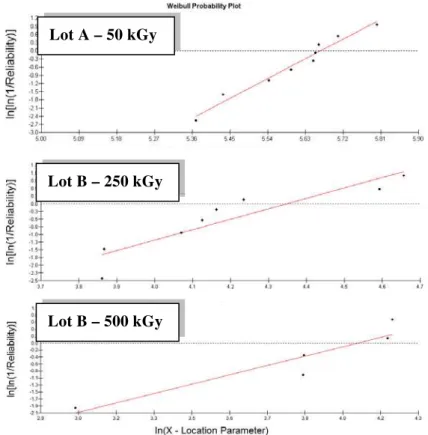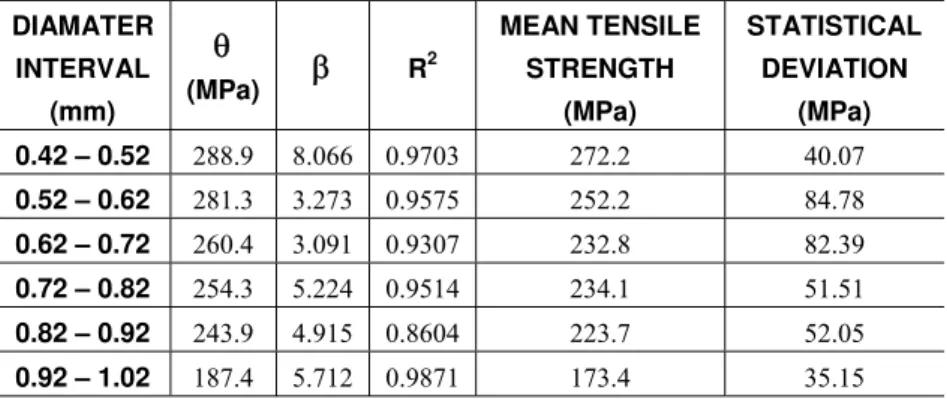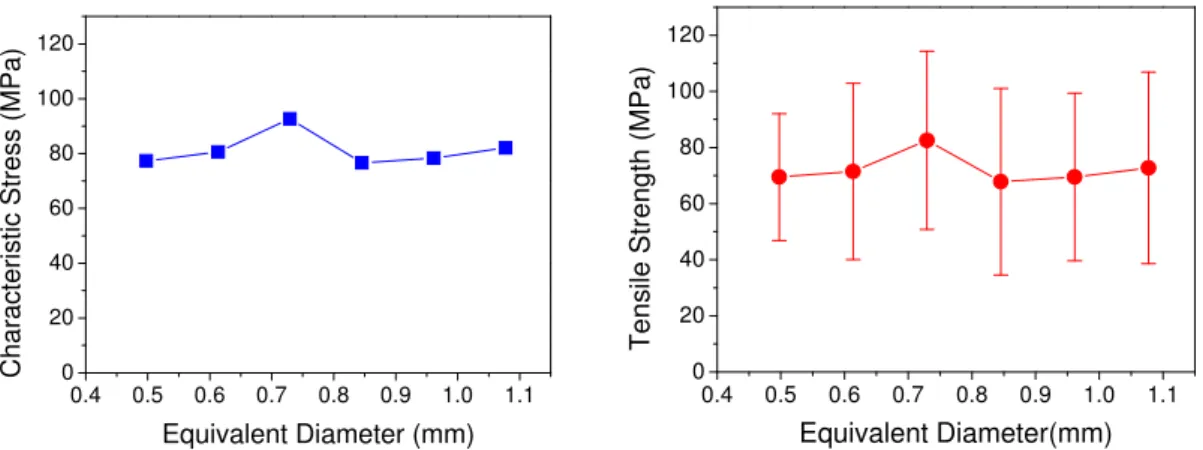ISSN 1517-7076 artigo 11484, pp.1135-1143, 2012
Autor Responsável: Barbosa, A. P. Data de envio: 21/10/10 Data de aceite: 06/10/12
Effect of electron beam irradiation on the
mechanical properties of buriti fiber
Barbosa, A. P. 1, Costa, L L. 1, Portela, T. G. R. 1, Moura, E. A.2, Del Mastro, N. L. 2, Satyanarayana, K. G. 3, Monteiro, S. N. 4
1
State University of the Northern Rio de Janeiro, UENF,
e-mail: apbarbosa12@yahoo.com.br ; luclopes_@hotmail.com ; tammygodinho@gmail.com 2
IPEN, São Paulo, SP, Brazil
e-mail: eabmoura@ipen.br ; nlmastro@ipen.br 3
Acharya Research & Development Center, Soladevanhalli, Bangalore, India e-mail: kgs_satya@yahoo.co.in
4
IME: Military Institute of Engineering, Department of Materials Science, Praça General Tibúrcio, 80, 22290-270, Rio de Janeiro, Brazil.
e-mail: sergio.neves@ig.com.br
ABSTRACT
Natural fibers, mainly those lignocellulosic extracted from plants, have, in the past few decades, attracted the attention not only of scientists but also of industrial technologists of our society interested in their engineering materials. As it is well known, uses of natural fiber in clothes carpets, baskets, ropes and low cost construction roofing has existed from the beginning of our civilization. Today environmental and energy saving issues are motivating research works on new uses of lignocellulosic fibers in polymer composites. Moreover, industrial application of lignocellulosic fiber composites are already in technological sectors such the automobile industry, packing and civil construction. In addition to environmental, economical and social benefits, some lignocellulosic fibers present specific properties that are not comparable to those of other synthetic fiber used for polymer composite reinforcement. In fact, the mechanical strength and stiffness of any natural fibers is, however, significantly inferior and needs to be improved in order to compete with those of the synthetic fibers. The present work investigated the effect of electron beam irradiation on the mechanical behavior of the buriti petiole fiber, which presents a potential for composite reinforcement. Distinct lots of buriti fibers were irradiated at 50, 250 and 500 kGy using a 1.5 MeV electron beam accelerator. The results showed marked changes in the tensile properties of the buriti petiole fiber. This was discussed in terms of the structural modifications occurring in the irradiated lignocellulosic structure.
1136
1. INTRODUCTION
The use of materials extracted from plants can be traced back to thousands of years [1]. It is documented that wood and other lignocellulosic materials have been used from the beginning of our civilization. In particular, there are evidences that lignocellulosic fibers were, since then, applied in simple items such as ropes, baskets, roofing and even as reinforcement of sun-dried clayey adobe in earlier building construction. In the past century, however, synthetic fibers fabricated from polymers, glass and carbon continuously replaced the natural fibers in their traditional applications. Moreover, the synthetic fibers were preferentially considered for composite reinforcement [2-4] owing to their superior strength and stiffness.
Today, a reverse trend in favor of lignocellulosic fibers is taking place as a consequence of environmental problems related to the synthetic fibers. In fact, synthetic fibers require a relatively large amount of energy for their production and processing. This corresponds to a surplus of CO2 emission, which is the main responsible for global warming. Synthetic fibers and their composites cannot also be recycled and cause long term pollution after discard. Thus, a considerable number of works has in recent years been dedicated to the investigation and possible applications of composites alternatively reinforced with lignocellulosic fibers [5-10]. In addition to environmental benefits, lignocellulosic fibers also present economical societal and some technical advantages [9, 10]. By contrast, they also possess drawbacks in terms of low adhesion to polymer matrices as well as non-uniform properties. In spite of these limitations, efforts are being made to improve the mechanical performance not only of the lignocellulosic fibers but also their reinforced composites [11]. A possible way to increase the strength of a lignocellulosic fiber or its polymeric composite is by subject them to radiation [12, 13].
It is well known that radiation may significantly affect molecular materials even for relatively small doses [12]. Inter and intra-molecular reactions may promote crosslink and reticulate network in a macromolecular structure, either natural or synthetic, which has been irradiated. For instance, ionizing irradiation of a polymeric material is able to break chemical bonds and introduce modification in the material behavior [12-14]. Several works [15-20] have shown that macromolecular products such as natural fibers, biomaterials and polymers may improve their properties by ionizing irradiation as a result of crosslinking and scission processes, in which radicals are formed throughout the chains.
The fiber extracted from the petiole of the buriti palm tree has recently been investigated as a promising reinforcement for polymer composites [21-23]. However, the strength of this fiber, of the order of 200 MPa, is lower than other lignocellulosic fibers, such as curaua, ramie and sisal [11]. It was then investigated in the present work, the possibility of improving the strength of buriti petiole fibers by electron beam irradiation.
2. EXPERIMENTAL PROCEDURE
1137
Figure 1: The buriti palm tree (a), petioles (b) and extracted fibers (c).
Figure 2 shows the histograms corresponding to the statistical distribution of diameters for each lot of buriti fiber before irradiation. In this figure one should notice that each lot was conventionally divided in 6 intervals of diameter from 0.42 to 1.02 mm. Although the actual distribution varies for every corresponding interval in each lot, the mean diameter per lot is approximately the same, dm = 0.7 mm and similar to another value of dm = 0.6 mm found elsewhere [22].
Buriti fibers from the three different lots were cleaned and dried before electron beam irradiation. Irradiation was conducted in a model Dynamitron II Radiation Dynamics electrostatic accelerator operating at 25°C, in the presence of air, with a beam width of 100 cm. The dose rate was 22.42 kGy/s associated with an energy of 1.487 MeV, a beam current of 5.59 mA and a tray speed of 6.72 m/min. The total applied dose for fibers of lot A was 50 kGy; lot B was 250 kGy, and lot C 500 kGy. The dose measurements were carried out with cellulose triacetate film dosimeters model CTA FTR 125 Fuji Photo Film. After irradiation, the buriti fibers were stored inside plastic bags in a dried and protected ambient until being tested.
0.4 0.5 0.6 0.7 0.8 0.9 1.0 1.1 0
5 10 15 20 25 30
Fr
eq
ue
nc
y
(%
)
Equivalent Diameter (mm)
dm = 0.74 mm
Lot A
0.4 0.5 0.6 0.7 0.8 0.9 1.0 1.1 0
5 10 15 20 25
Equivalent Diameter (mm)
dm = 0.69 mm Lot B
0.4 0.5 0.6 0.7 0.8 0.9 1.0 1.1 0
5 10 15 20
Equivalent Diameter (mm)
dm = 0.70 mm
Lot C
Figure 2: Histograms of diameter distribution for lots A, B, and C of buriti petiole fibers.
1138
3. RESULTS AND DISCUSSION
For each diameter interval presented in Figure 2, ten fibers were tensile tested and the ultimate strength, σm, of every fiber was calculated by the maximum force, Fm, divided by the fiber cross-section area with average equivalent diameter, de, as shown in the following equation.
σm = 4Fm/πde (1)
The results of the tensile strength of each fiber belonging to the diameter intervals, Figure 2, for the three lots of buriti fibers electron beam irradiated with different doses, were statistically analyzed using the Weibull method. This method permits to construct graphs such as the ones in Figure 3 for set of points corresponding to each diameter interval.
Figure 3: Examples of Weibull graphs for the intervals of thinner diameters (0.42<de<0.52) for the three lots irradiated with different doses.
In this figure, as illustrative examples, only the graphs for the interval of thinner diameters, from 0.42 to 0.52 mm are presented. Here it is important to mention that all Weibull graphs, like the ones in Figure 3, are unimodal, i.e., with just one fitting straight line. This is an indicative that fibers associated with a given diameter interval have the same mechanical behavior.
The Weibull Analysis program also provides the values of corresponding parameters for each diameter interval: characteristic stress (θ), Weibull modulus (β), and the precision adjustment (R2). Tables 1 to 3 present for irradiation doses of 50, 250 and 500 kGy, respectively, these Weibull parameters as well as the mean tensile strength and corresponding deviation for each diameter interval. It should be noted in these tables the relatively good values of R2, indicating a reasonable adjustment of the results.
Lot A – 50 kGy
Lot B – 250 kGy
1139 Table 1: Weibull parameters for the tensile strength of buriti fibers associated with different diameter intervals and electron beam irradiated with 50 kGy
DIAMATER
INTERVAL (mm)
(MPa) R
2
MEAN TENSILE
STRENGTH (MPa)
STATISTICAL
DEVIATION (MPa)
0.42 – 0.52 288.9 8.066 0.9703 272.2 40.07
0.52 – 0.62 281.3 3.273 0.9575 252.2 84.78
0.62 – 0.72 260.4 3.091 0.9307 232.8 82.39
0.72 – 0.82 254.3 5.224 0.9514 234.1 51.51
0.82 – 0.92 243.9 4.915 0.8604 223.7 52.05
0.92 – 1.02 187.4 5.712 0.9871 173.4 35.15
Table 2: Weibull parameters for the tensile strength of buriti fibers associated with different diameter intervals and electron beam irradiated with 250 kGy
DIAMATER INTERVAL
(mm)
(MPa) R
2
MEAN TENSILE STRENGTH
(MPa)
STATISTICAL DEVIATION
(MPa)
0.42 – 0.52 77.34 3.393 0.8459 69.47 22.61
0.52 – 0.62 80.61 2.427 0.8529 71,47 31.41
0.62 – 0.72 92.66 2.815 0.8024 82.53 31.75
0.72 – 0.82 76.56 2.147 0,9593 67.8 33.25
0.82 – 0.92 78.34 2.488 0.92 69.5 29.87
0.92 – 1.02 82.12 2.257 0.8871 72.74 34.11
Table 3: Weibull parameters for the tensile strength of buriti fibers associated with different diameter intervals and electron beam irradiated with 500 kGy
DIAMATER INTERVAL
(mm)
(MPa) R
2
MEAN TENSILE STRENGTH
(MPa)
STATISTICAL DEVIATION
(MPa)
0.42 – 0.52 58.93 2.028 0.872 52.21 26.95
0.52 – 0.62 39.69 2.86 0.9096 35.37 13.42
0.62 – 0.72 45.68 3.579 0.8318 41.45 12.76
0.72 – 0.82 35.44 2.248 0.8704 31.39 14.77
0.82 – 0.92 43.95 2.545 0.9584 39.01 16.43
0.92 – 1.02 25.2 1.455 0.9883 22.84 15.95
1140
0.4 0.5 0.6 0.7 0.8 0.9 1.0 0 100 200 300 400 Charac teristi c S tress (M P a )
Equivalent Diameter (mm)
0.4 0.5 0.6 0.7 0.8 0.9 1.0 0 100 200 300 Tensile S trength (MPa)
Equivalent Diameter (mm)
Figura 4: Variation of the characteristic stress and the tensile strength with the diameter of buriti fibers electron beam irradiated with 50 kGy
0.4 0.5 0.6 0.7 0.8 0.9 1.0 1.1 0 20 40 60 80 100 120 Characteris tic Stress (MPa)
Equivalent Diameter (mm)
0.4 0.5 0.6 0.7 0.8 0.9 1.0 1.1 0 20 40 60 80 100 120 Te n s ile Str e ng th (MP a ) Equivalent Diameter(mm)
Figura 5: Variation of the characteristic stress and the tensile strength with the diameter of buriti fibers electron beam irradiated with 250 kGy.
0.4 0.5 0.6 0.7 0.8 0.9 1.0 1.1 0 20 40 60 80 Ch a ra c te ri sit c St re ss (M Pa )
Equivalent Diameter (mm)
0.4 0.5 0.6 0.7 0.8 0.9 1.0 1.1 0 20 40 60 80 Te nsile Stre n g th ( MPa)
Equivalent Diameter (mm)
1141 Secondly, in average, the values of θ and σm shown in Figure 4 are almost 30% greater than those for the non-irradiated fibers [22]. This clearly indicates that the 50 kGy electron beam irradiation improves the buriti fiber strength. By contrast, for the higher irradiation doses of 250 kGy in Figure 5 and 500 kGy in Figure 6, there is a significant decrease in θ and σm. In other words, relatively higher doses can markedly impair the tensile strength of the buriti fiber. The reason for this behavior can be understood in terms of microstructure effects caused by the irradiation.
Figure 7 presents, with the same magnification of 50X, typical SEM micrographs of tensile ruptured buriti fibers irradiated with different doses. In this figure, it is observed that the fracture of fibers subjected to the lower dose of 50 kGy, Figure 7(a), has a significant participation of fibrils and evidence of plastic fracture. In fact, the sequential rupture of fibrils is able to support an increasing applied force to a lignocellulosic fiber [9]. For greater doses corresponding to 250 kGy, Figure 7(b), and 500 kGy, Figure 7(c), however, the participation of individual fibrils is no longer observed. A buriti fiber subjected to these higher doses presents not only a totally brittle fracture, but also evidence of damages associated with surface degradation in terms of cavities and warped structures.
Figure 7: SEM micrographs of tensile ruptured buriti fibers subjected to electron beam irradiation doses of (a) 50, (b) 250 and (c) 500 kGy (50X).
4. CONCLUSIONS
Electron beam irradiation of fibers extracted from the petiole of buriti palm tree caused significant changes in the tensile strength as revealed by Weibull statistical analysis.
For the lower doses of 50 kGy, in average, the buriti fibers became almost 30% stronger than similar non-irradiated fibers. Moreover, there is evidence of an inverse relationship between the strength and the diameter such as that the thinner the diameter, the stronger the fiber.
For higher doses, 250 and 500 kGy, the fiber strength was markedly decreased, which could be attributed to structural damages in association with brittle fracture.
5. ACKNOWLEDGEMENTS
The authors thank the support to this investigation by the Brazilian agencies CNPq, CAPES, FINEP and FAPERJ.
6. REFERENCES
[1] SATYANARAYANA, K.G., GUIMARÃES, J.L., WYPYCH, F., “Studies on lignocellulosic fibers of Brazil. Part I: Source, production, morphology, properties and applications”, Composites: Part A, vol. 38, pp.1694-1709, 2007.
1142 [2] ASHBEE, K.H., Fundamental, principles of fiber reinforced composites, 2nd ed., Lancaster, Technomic Publ. Company, 1993.
[3] MALLICK, P.K., Fiber-reinforced composites, materials manufacturing and design, 2nd ed., Marcel Dekker Publ, New York,., 1993.
[4] CHAWLA, K.K., Composite materials science and engineering, 2nd ed., Spring-Verlag, New York, , 1998.
[5] BLEDZKI, A.K., GASSAN, J., “Composites reinforced with cellulose-based fibers”, Progress in
Polymer Science, v. 24, n. 2, pp. 221-274, 1999.
[6] NABI-SAHED, D., JOG, .J.P., “Natural fiber polymer composites: a review”, Advances in Polymer
Technology, v. 18, n. 4, pp. 221-274, 1999.
[7] MOHANTY, A.K., MISRA, M., DRZAL, L.T., “Sustainable biocomposites from renewable resources: opportunities and challenges in the green material world”, Journal of Polymer Environment, v. 10, n.1-2, pp. 9-26, 2002.
[8] CROCKER, J., “Natural materials innovative natural composites”, Materials Technology, v. 2-3, pp.174-178, 2008.
[9] MONTEIRO, S.N., LOPES, F.P.D., FERREIRA, A.S., et al., “Natural fiber polymer matrix composites: cheaper, tougher and environmentally friendly”, JOM, v. 61, pp. 17-22, 2009.
[10] ZAH, R., HISCHIER, R., LEÃO, A.L. et al., “Curaua fibers in automobile industry – A sustainability assessment”, Journal of Cleaner Production, v. 15, n.11-12, pp. 1032-1040, 2007.
[11] MONTEIRO, S.N., SATYANARAYANA, K.G., LOPES, F.P.D., “High strength natural fibers for improved polymer matrix composites”, Materials Science Forum, v. 638-642, pp. 961-966, 2010.
[12] CLEGG, D.W., COLLYER, A.A., Irradiation effects on polymers, London, Elsevier Science Publishers, 1991.
[13] CHOI, H.Y., HAN, S.O., LEE, J.S., “Surface morphological, mechanical and thermal characterization of electron beam irradiated fibers”, Applied Surface Science. v. 255, pp. 2466-2473, 2008.
[14] TAKINAMI, P.Y.I., SHIMAZAKI, K., COLOMBO, M.A., et al., “Gelatin/piassava composites treated by electron beam radiation”, Revista Matéria, v. 15, n. 2, pp. 339-344, 2010.
[15] BUCHALLA, R., SCHÜTTLER, C., BÖGL, K.W., “Effect of ionizing radiation on plastic food
packaging materials: a review, Part 1. Chemical and Physical Changes”, Journal of Food Protection, v. 56, n. 11, pp. 991-997, 1993.
[16] MACHI, S., “New trends of radiation processing applications”, Radiation Physics and Chemistry, v. 47, n. 3, pp. 333-336, 1996.
[17] DORSCHNER, H., LAPPAN, U., LUNKWITZ, K., “Electron beam facility in polymer research: radiation induced functionalization of polytetrafluoroethylene”, Nuclear Instruments and Methods in Physics
Research B, v. 139, pp. 495-501, 1998.
[18] KHAN, F., AHMAD, S.R., KRONFLI, E., “Stability of jute fibers on exposure to ionizing radiation”,
Polymer Degradation and Stability, v. 63, pp. 79-84, 1999.
[19] ROUIF, S., “Radiation cross-linked polymers: Recent developments and new applications”,
Nuclear Instruments and Methods in Physics Research B, v. 236, pp. 68–72, 2005.
[20] RATNAM, C.T., RAJU, G., YUNUS, W.Z.W., “Oil palm empty fruit bunch (OPEFB) fiber reinforced PVC/ENR blend-electron beam irradiation”, Nuclear Instruments and Methods in Physics Research B. v. 265, pp. 510-514, 2007.
[21] SANTOS, N.S.S., DIAS, C.G.B.T., SANCHES, E.M.S., et al., “Microstuctural and mechanical
1143 Proceedings of the Brazilian Congress on Materials Science and Engineering – 18 CBECIMAT, pp. 3565-3573, Porto de Galinhas, PE, Brazil, November 2008.
[22] PORTELA, T.G.R., COSTA, L.L., LOPES F.P.D., et al., “Characterization of fibers from different parts of the buriti palm tree”, In: Proceedings of the TMS – Conference, Characterization of Minerals Metals & Materials Symposium, pp. 1-7, Seattle, USA, March 2010.




